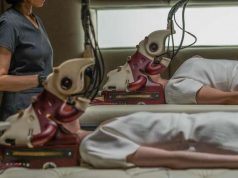
It’s time once again to put a movie trend under the microscope and examine it … with Science! Our subject today is body-swap movies. Specifically: what is the deal with body-swap movies, scientifically speaking?
The body-swap comedy is based on a simple premise: What would you do if you could switch places with someone? The correct answer to that question is that you can’t, what a stupid idea, so don’t worry about it. But WHAT IF?? How would it work? What would happen? Must hilarity ensue, or would there also be potential for somber reflection?
If the two people switching bodies are the same gender and have approximately the same body type and general state of health, then there would not be any significant physical problems. It would be like moving into a new house that has pretty much the same floor plan as your old one. But the greater the differences between the bodies, the more trouble there would be. For example, if a 5-foot-tall man were to switch bodies with a 7-foot-tall man, he would find himself bumping his head a lot, as he would not be accustomed to his height. Likewise, the tall man would do a lot of stooping at first, until he got used to his shorter body.
Or consider an obese man who suddenly finds himself inhabiting a slim, athletic body. He would feel lighter than air, like an astronaut on the moon. He would also discover that the amount of food he’s used to eating would be way too much for his new, smaller physique. The fit guy, on the other hand, would feel like he’s carrying around a hundred-pound weight all of a sudden, and his usual supply of energy and pep would be insufficient. He would also discover that his normal food intake isn’t nearly enough to keep this massive machine running. He would also be very reluctant to see himself naked, whereas the fat-guy-now-in-a-thin-body would stand in front of a mirror all day, marveling.
It could get even more complex than this. What if a concert pianist switched bodies with someone whose fingers are short and stubby? The pianist would retain all his skills, yet would be unable to apply them. His new hands simply wouldn’t be able to do what his brain was telling them to do. In a way, that might be even more frustrating than a pianist switching places with someone who is fingerless altogether.
Now we get to the real heart of the matter. When two people switch bodies, what, exactly, are they trading? The many films produced on this subject seem to suggest that it is their “minds” — i.e., the whole of their memories, personalities, and thoughts. But the “mind” is a nebulous thing, like the soul. Scientifically speaking, everything associated with the “mind” is stored in the brain. But the body-switchers are not literally trading brains. That’s a whole different genre of movie, the brain-trading mad-scientist movie. What the body-swappers are doing is somehow trading the information in their brains without trading the actual brains. It’s like trading computers with someone, except you keep your own computers and just swap the data. What no film has done so far is attempt to explain how the data swap is accomplished, but we assume it involves Wi-Fi.
So what happens if the swap occurs between two people whose brains are physically different? For example, the guy in “Memento” suffered a head injury and now has anterograde amnesia, which means he cannot form new memories. If he switched bodies with a normal person, he’d find that he’d be able to form new memories again, because there’s nothing wrong with the other person’s brain. The other person, however, now inhabiting the brain-damaged body, would have anterograde amnesia.
You don’t need a head injury to be brain-damaged, either. Taking drugs over an extended period of time will do some harm. Not enough to make you an idiot, maybe, but enough to where a really intelligent non-drug-user suddenly inhabiting your body wouldn’t be as smart as he used to be.
What we’re discovering, then, is that the body-swap comedies have oversimplified things. It’s not just a straight-across trade of memories and personalities. There may be things about the new body or its brain that would prevent the transferred person from experiencing full functionality, just as a piece of state-of-the-art software won’t work right if you download it to a computer with a processor that’s too slow.
But let us assume that the two people switching places are both healthy physical specimens with undamaged brains. That will minimize the physiological problems they encounter. But we mustn’t underestimate the impact that our attitudes and behaviors have on our experiences.
Let’s say our body-swappers have wholly different personalities. One is cynical, negative, angry, and rude, while the other is optimistic, friendly, generous, and kind. We’ll call them Mr. Mean and Mr. Nice. Body-swap movies tend to assume that when Mr. Mean inhabits Mr. Nice’s body, everyone will treat him the way they normally treat Mr. Nice — because, after all, he LOOKS like Mr. Nice, and they have no reason to assume he isn’t Mr. Nice, since body-swapping is impossible.
That’s undoubtedly how it would go at first. Mr. Mean would learn what it’s like to be Mr. Nice, with everyone smiling at him and enjoying his company. Mr. Nice, meanwhile, would find that being Mr. Mean is rather unpleasant, since those around him are afraid of him or hostile toward him. But before long, both men’s personalities would come through. “Mr. Nice” would surprise his colleagues by being abrasive and awful, and “Mr. Mean” would surprise his colleagues by being pleasant — and their colleagues would respond in kind. People won’t keep treating the guy who looks like Mr. Nice as if he were Mr. Nice if he stops being Mr. Nice.
Finally, there is the question of what happens when the people trading places are different genders. The answer is that both parties are so grossed-out that they become catatonic and die, the end.
— Film.com




